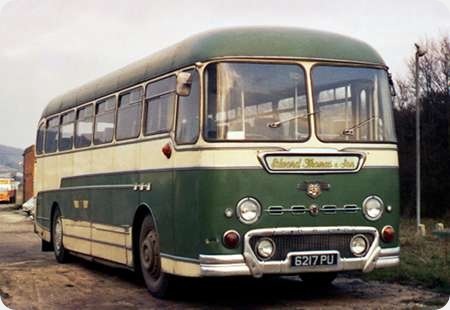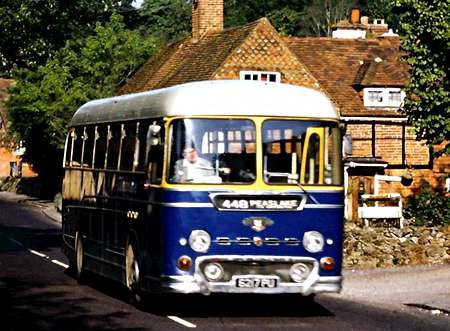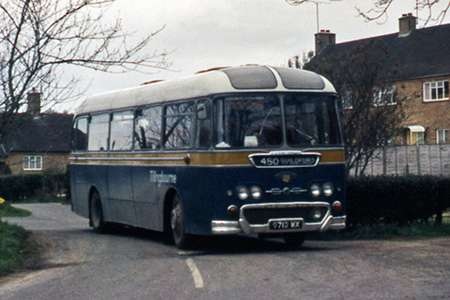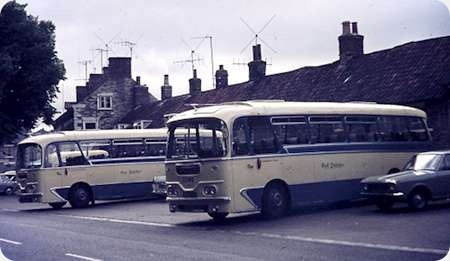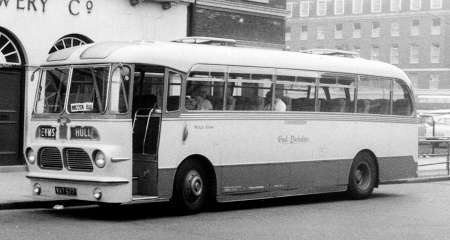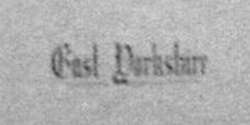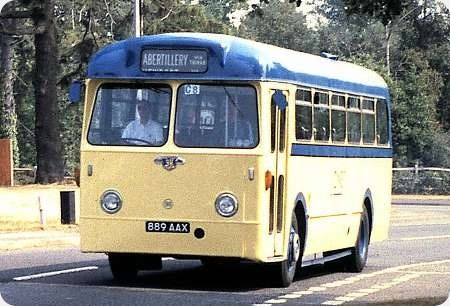Edward Thomas and Son – Leyland Tiger Cub – 6217 PU
Edward Thomas and Son
1961
Leyland Tiger Cub PSUC1/2
Duple C41F
This is a Leyland Tiger Cub PSUC1/2 with a Duple Donington C41F body that was bought initially for staff transport by the Shell Oil company in 1961. It went to Edward Thomas of West Ewell, near Epsom, Surrey in November 1968, who in turn disposed of it in December 1974 to Trevor Brown, proprietor of the Tillingbourne Bus Company. In December 1975 it was sold to Hargreaves of Newbury. 6217 PU is seen here in Tillingbourne ownership, though still wearing the livery of Edward Thomas, parked in the yard beside Gomshall railway station that then served as Tillingbourne’s operating base, to the chagrin of Guildford Borough Council who consistently pressured the company to find other premises. I always liked the Tiger Cub model, though the five speed constant mesh gearbox required proper respect for clean changes, and the Donington body (this is the second version, still with shallow windows), together with the Elizabethan and Britannia, represented Duple UF bodywork design at its best. Thereafter in the 1960s Duple abandoned all restraint and went completely downhill in my view, initially by adopting a bulbous front end derived from the front engined models, and later going completely overboard with a mish mash of uncoordinated styling features embellished with a truly ghastly, garish, Detroit ‘inspired’ front grille. Even when the firm finally pulled itself together and adopted the Plaxton clone Dominant design it was still just a pale imitation of the Scarborough original.
Photograph and Copy contributed by Roger Cox
13/06/16 – 17:17
Whilst not the best image and taken from my slide , I can attach a picture of 6217PU repainted into Tillingbourne colours and seen in Shere village.
Keith Newton
14/06/16 – 06:07
When did the Tillingbourne livery change from the maroon?
I seem to remember, from using Guildford bus stations through to as late as 1959 that their buses and Brady,s Brown Buses were actually quite close in colour/hue.
John Lomas
14/06/16 – 11:16
Does anybody have a picture of this in Shell Oil livery? If it was in the same corporate colours as their tanker fleet it might be quite attractive.
Neville Mercer
14/06/16 – 17:43
On 30 September 1970, Trevor Wilcox Brown of Grayshott bought the Tillingbourne Valley operations and its GS buses From the Trice family that had started the business on Easter Bank Holiday in 1924. At first the maroon livery and Tillingbourne Valley trading name continued, though slightly changed, but in April 1972, GS MXX 364 appeared in a new livery of blue with a white roof and a yellow relief band below the windows. The company became the Tillingbourne Bus Company and the fleetname, in a bolder style, was reduced to just ‘Tillingbourne’. This then became the fleet standard but, over subsequent years until the company’s abrupt demise in April 2001, the livery underwent several changes with yellow generally becoming the predominant colour. Back to the Tillingbourne Tiger Cubs. The company had three of these with Donington bodywork, the one shown above plus two from Pennine of Gargrave, 6108 WU and 9712 WX. A fourth Tiger Cub in the fleet, VCH 172, had a Willowbrook DP41F body, and came from Watson’s and Goodman’s & Tours, t/a Ford of Gunnislake. Here is a shot of 9712 WX pictured during one of my Saturday driving stints with it on the 450 Farley Green – Guildford route in 1974. This vehicle had the final and in my opinion the best version of the Donington body, with deeper saloon windows that matched the height of the windscreen. It was a very pleasant vehicle to drive.
Roger Cox
15/06/16 – 07:10
The recent picture of 6217 PU made me (excitedly) put pen to paper and before I knew it I have written a bit of a personal memoir of the Shell Refining private bus service that operated in the 1950s until the mid 1960s. I am afraid I have strayed well of the mark for an answer to the question what colour was it when new – which is what kicked off my thoughts. Perhaps you might like to start it as a new subject though it is a bit short on bus detail. I was after all, only eight when 6217 PU was new. I have referenced some other local activities too. All photos are from my collection and the one of 838 HNO was taken by the late Peter Snell who gave me a copy years ago.
Nick Webster
Nicks copy and photos can be viewed at this link ‘Shell Refining’s Private Bus Service’
Quick links to the - Comments Page - Contact Page - Home Page
